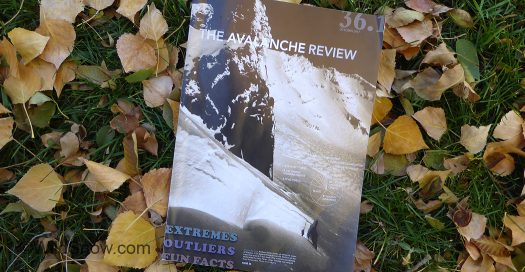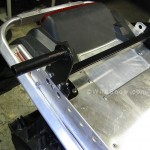Nothing new about snowmobiles being an important SAR tool. Yet anything can be improved — as well as repurposed.
October 2017 issue of Avalanche Review includes an excellent article on just that subject: using sleds for both access and the actual beacon search. (Article is published online at BCA Backcountry Access website). Scoot around on the debris pile with your sled while operating your transceiver? I’d never thought of that! Article authors Mike Duffy (avalanche educator) and Bruce Edgerly of BCA cover plenty of ideas in regard. Their presentation is somewhat oriented towards organized rescue crews, but applies to groups of recreational sledders or sled-skiers as well.

Avalanche Review 36.1 includes article covering snowmobiles as avalanche rescue tool.
Overarching concept is that modern sleds can boogie around on avalanche debris much faster than a walker. It goes unsaid that several sledders moving around a smaller deposition could get in each other’s way, but in my view the concept is valid. Below are a few bullet points from the article, with my thoughts.
Gear ideas
Beware of the huge heavy “utility sleds.” To the inexperienced they look like the ticket, but they’re not. Nearly impossible to get unstuck and they ride like a dead alligator. What you want is a long tracked mountain sled with plenty of power.
Always carry spare goggles as well as either another pair with clear lens, or replacement lens. It’s surprising how dim a sled headlight actually is compared to the sun, night riding with tinted goggles is compromised.
Carry two shovels, one on the sled and one in your backpack. If you auger in, use the sled shovel for the digout so you can keep your pack on (especially important if you rock an airbag rucksack). Much better than shedding your backpack and having it end up in the melee, or worse, being hit by an avy and unburied — needing to dig out your friend — and your shovel pack is buried.

My current ski rack protrudes from tunnel, possibly causing injury if driver comes off the sled to the rear. Readers have commented on this, glad to get more incentive to re-design. I’m on it.
The best ski racks carry your planks longitudinally to the long axis of the sled, at a low angle. In other the skis resemble “tails” or “fins” perhaps protruding a few feet beyond the rear of the track tunnel. This is super important in timbered terrain where low branches break things they encounter, as well as preventing a snapping sound in the event you roll your sled. My sled’s ski rack holds planks at a low angle, but it does have parts that protrude from the tunnel. Duffy mentions in his part of the article that racks like mine can injure if you come off the sled backwards while it’s under power. Good point, perhaps time for another build.
We have a pile of WildSnow content regarding snowmobile ski racks.
Rescue thoughts
I don’t ride much with my kill switch tether, probably should. In a rescue situation you would probably untether so you can quickly move on and off your sled. In my view, tethers are important if you ride fast in terrain where your sled could “ghost” down over a cliff or into a tree, but not so important when you’re moving methodically in rougher topography, such as a debris field?
Ride your sled to where you deem your beacon search should begin. Leave it running (to avoid starting problems), hop off and move about six feet away to obviate any EMI. The article says BCA has found that most operating snowmobile engines compromise beacon performance if you’re close.
The article goes on to describe doing a beacon search that involves riding your sled. Doing so sounds complex, with obvious issues of overshooting the victim location. The procedure depends on acquiring accurate distance and direction readings. Modern beacons do that quite well, but still require patience and practice if you’re going to depend on the numbers. Thus, just as the best companion rescue requires practice, if you do much sledding in avy terrain it’s probably a good idea to set up a few “sled rescue” simulations with your friends. Begin by acquiring a copy of Avalanche Review 36.1, October 2017.
I know a number of WildSnow readers are experienced snowmobilers. Any of you guys thought on how you’d utilize your sled in the event of an avalanche rescue?
WildSnow.com publisher emeritus and founder Lou (Louis Dawson) has a 50+ years career in climbing, backcountry skiing and ski mountaineering. He was the first person in history to ski down all 54 Colorado 14,000-foot peaks, has authored numerous books about about backcountry skiing, and has skied from the summit of Denali in Alaska, North America’s highest mountain.
